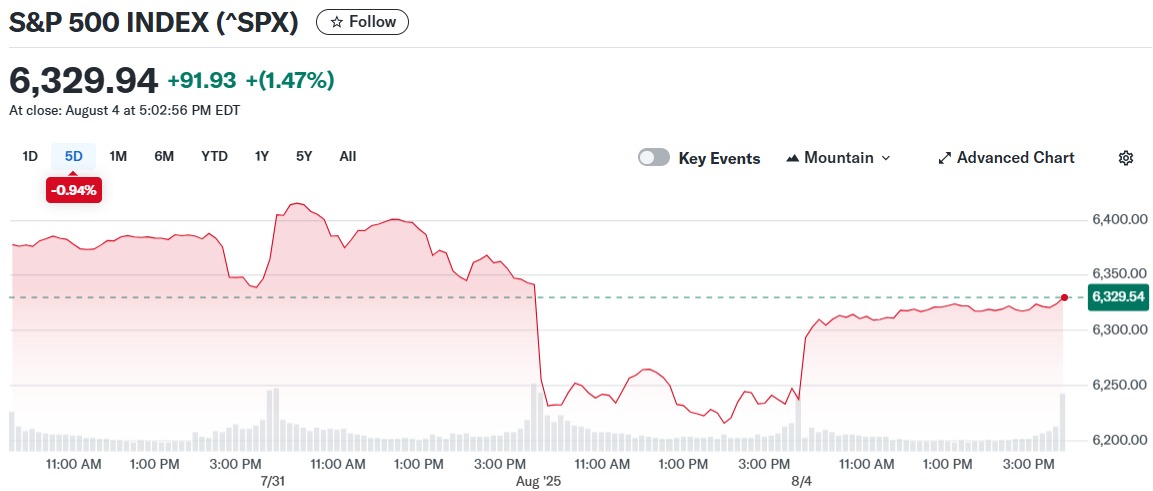TLDR
- Dow Jones surged 585 points (1.34%) to close at 44,173.64, wiping out Friday’s losses
- S&P 500 gained 1.47% and Nasdaq jumped 1.95%, both posting best session since May
- Market rally driven by expectations of Federal Reserve interest rate cuts in September
- Weak jobs data sparked optimism that Fed will lower rates to support the economy
- Trump fired Bureau of Labor Statistics head and announced new tariff rates on trading partners
Wall Street experienced a strong recovery Monday as major indices bounced back from Friday’s steep sell-off. The rally was fueled by growing expectations that the Federal Reserve will cut interest rates in September following weaker-than-expected employment data.
The Dow Jones Industrial Average climbed 585.06 points, or 1.34%, to close at 44,173.64. This gain completely erased Friday’s losses and marked a decisive turnaround for the blue-chip index.
The S&P 500 advanced 1.47% to end at 6,329.94, snapping a four-day losing streak. The Nasdaq Composite posted even stronger gains, surging 1.95% to settle at 21,053.58.

Both the S&P 500 and Nasdaq recorded their best trading session since May. Technology stocks led the charge, with blue-chip names like Nvidia, Meta, and Microsoft reaching record highs during the session.
Rate Cut Expectations Drive Rally
The market’s optimism centered on Friday’s disappointing jobs report, which showed weaker employment growth than anticipated. The data included heavy revisions to May and June employment figures, painting a less robust picture of the labor market.
Investors interpreted this weakness as a signal that the Federal Reserve may need to cut interest rates sooner than previously expected. Lower interest rates typically make stocks more attractive compared to bonds and other fixed-income investments.
Sam Stovall, chief investment strategist at CFRA Research, described Monday’s action as “sort of a bounce-back day.” He noted that stocks tend to recover after sharp declines, which explains the current rebound.
However, Stovall cautioned that investors should monitor Tuesday’s trading carefully. He suggested that some market participants might choose to take profits after Monday’s gains.
Political Developments Add Volatility
President Donald Trump’s response to the jobs data created additional market volatility. Shortly after the employment report’s release, Trump fired the head of the Bureau of Labor Statistics.
Trump announced he would name a new BLS commissioner in the coming days. This move injected political uncertainty into the economic data discussion.
The president also signed an executive order updating his “reciprocal” tariffs on dozens of U.S. trading partners. The new duties range from 10% to 41% and affect countries from Syria to Taiwan.
These tariff developments initially rattled markets, adding to concerns about trade policy impacts. However, the rate cut optimism ultimately overshadowed these worries.
Treasury Secretary Scott Bessent provided some positive news regarding U.S.-China trade relations. Speaking to CNBC Thursday, Bessent said “we have the makings of a deal” following meetings between senior officials from both countries in Stockholm, Sweden.
With limited economic data scheduled for this week, investors will focus on trade developments and corporate earnings. Palantir is set to report results after Monday’s close, while AMD will announce earnings Tuesday.
Market participants are also preparing for what historically has been a challenging month for stocks. August ranks as the worst month for the Dow Jones Industrial Average since 1988 data began, and the second-worst for both the S&P 500 and Nasdaq Composite.
Stay Ahead of the Market with Benzinga Pro!
Want to trade like a pro? Benzinga Pro gives you the edge you need in today's fast-paced markets. Get real-time news, exclusive insights, and powerful tools trusted by professional traders:
- Breaking market-moving stories before they hit mainstream media
- Live audio squawk for hands-free market updates
- Advanced stock scanner to spot promising trades
- Expert trade ideas and on-demand support



